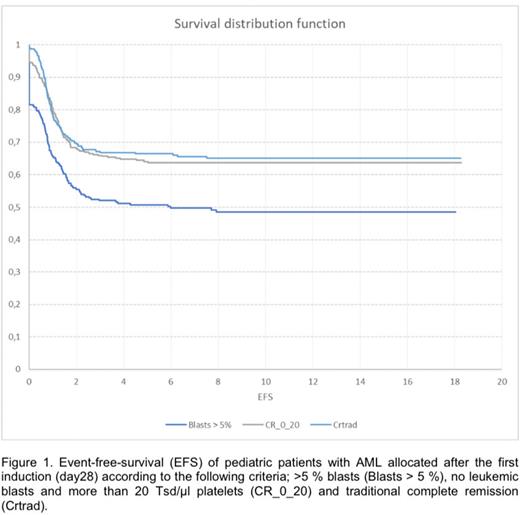Abstract
In AML, complete remission (CR) is traditionally defined by < 5 % blasts, absolute neutrophil count (ANC) < 1000/µL and platelets (plt) > 100000/µL in adult and > 80000/µL in pediatric AML (Cheson et al. 2003). This largely morphologically based definition has remained unchanged for more than two decades. Though proven as a valuable predictor of outcome and survival in clinical practice and trials, awaiting complete hematopoietic recovery still displays a hurdle of unknown prognostic significance in clinical practice. In addition, a great variety of diverse criteria, considering hematopoietic recovery, were established in clinical trials to counter this problem. Thus, the actual relevance of the inclusion of ANC and plt in the current CR definition needs to be reassessed and newly defined in pediatric AML.
Data of 1051 pediatric AML patients diagnosed between 2004 and 2020 have been analyzed. Acute promyelocytic leukemia, secondary-, treatment-related and Down syndrome-related AML were excluded. Patients were treated according the German pediatric AML-BFM studies and registries between 2004 and 2019 (Essen, Germany). Diagnostic bone marrow and peripheral blood samples from defined timepoints were collected and reviewed centrally. Patients were allocated to alternative response groups, using combinations of 5 % bone marrow blasts with different thresholds for ANC (250, 500 and 1000 / ul) and plt (20000, 50000 and 80,000 / µl). Survival and outcome of these stratified response groups were compared with the current, established CR criteria (blasts < 5%, ANC < 1000, 80000/ul; -CRtrad). Overall survival (OS) and event-free survival (EFS) were estimated by the Kaplan-Meier method and significance was determined using the log-rank statistic.
A total of 1051 patients with a median age at diagnosis of 8.4±6 year (y) were analyzed. OS and EFS were 79.4±1% and 61.2±2%, respectively. CR with hematological regeneration (ANC>1000/µl; Plt >80.000/µl) showed a similar outcome compared with CRp (ANC> 500/µl)/Plts >50000/µl) or CRp (ANC>200/µl; Plts >20000/µl) or "no blasts; Plts > 20000/µl). Only patients with >5% blasts after 1st induction have an inferior EFS (51±3%; p<0.01).
According to the centrally reviewed response data provided by the AML-BFM study group, the former CR definition in pediatric AML needs to be revised. Only the presence of leukemic blasts (>5%) after the 1st induction predicts a significantly inferior outcome (in IR and HR). Thus, postponement of the 2nd induction does not seem justified. Our results suggest that the Cheson criteria in AML should be omitted and replaced by a definition CR with ≥ 5% blasts.
Disclosures
Reinhardt:BMS: Membership on an entity's Board of Directors or advisory committees; Novartis: Membership on an entity's Board of Directors or advisory committees, Research Funding; Cerus: Membership on an entity's Board of Directors or advisory committees; Medac: Membership on an entity's Board of Directors or advisory committees; EUSA Pharma: Membership on an entity's Board of Directors or advisory committees; BlueBird Bio: Research Funding.
Author notes
Asterisk with author names denotes non-ASH members.


